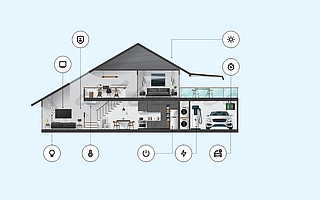Anwesenheitssimulation - das sollten Sie darüber wissen
Einbrecher vermeiden es meist in Gebäude einzusteigen, in denen jemand anwesend ist. Denn die Wahrscheinlichkeit, entdeckt zu werden, ist hoch. Eine professionell umgesetzte Anwesenheitssimulation gaukelt Außenstehenden vor, dass die Bewohner zu Hause sind, auch wenn diese zum Beispiel gerade in Urlaub sind.
Die Simulation der Anwesenheit der Bewohner dient vor allem dem Schutz vor einem Einbruch. Durch intelligente Automation wird das reguläre Nutzungsverhalten der Bewohner nachgeahmt, indem von außen wahrnehmbare Systeme und Geräte in der Wohnung in bestimmten Intervallen aktiviert werden. Dadurch wird einem potentiellen Einbrecher der Eindruck vermittelt, dass das Objekt bewohnt ist. Einbrecher haben übrigens immer Saison. Die weit verbreitete Meinung, sie werden vorwiegend in der Urlaubszeit sowie nachts aktiv, ist ein Irrglaube.
Einbrecher sind auf der Suche nach leichter Beute: Türe aufbrechen, wertvolle Sachen mitnehmen und ab durch die Mitte, lautet die Devise. Sind Hausbewohner anwesend, wird die Sache für die Einbrecher kompliziert und gefährlich, schließlich wissen die Kriminellen ja nicht, ob sie nicht bereits entdeckt wurden und die Polizei verständigt wurde.
Wichtig ist eine Impulssteuerung, die die Angewohnheiten der Bewohner täuschend echt nachahmt. So können Jalousien über ein entsprechendes Steuerungsmodul automatisiert heruntergelassen werden. Der genaue Zeitpunkt sollte jedoch zufallsbasiert ausgewählt werden, denn niemand lässt jeden Tag zur gleichen Zeit die Rollläden herunter. Soweit so gut. Bleibt noch die gute alte Türklingel. Denn Einbrecher klingeln gerne, wenn sie feststellen wollen, ob jemand zu Hause ist. Aber wenn man den ganzen Ablauf digitalisiert, ist das alles kein Problem. Eine automatische Video-Türklingel zeigt Ihnen auch im Urlaub, wer vor der Tür steht – auch eine Sprechverbindung mit dem Besucher ist möglich.
Die Simulation sollte realitätsnah sein, wenn der Bluff wirken soll. Denn Ihr Heim sollte bis ins kleinste Detail so aussehen, wie wenn jemand zuhause wäre. Deshalb sollten alle Abläufe und Zeitpläne im normalen Alltag nachempfunden werden. Je besser Ihre Smart-Home-Geräte miteinander vernetzt sind, desto einfacher kann das Risiko für einen Einbruch gesenkt werden. Natürlich sollten zusätzlich zur Anwesenheitssimulation auch die bewährten Regeln beachtet werden: So sind Briefkästen regelmäßig zu leeren, das Telefon ist zu beantworten bzw. weiterzuleiten und Einfahrt und Terrasse sind von Blättern und Laub zu befreien. Auch die Gartenarbeit sollte nicht vernachlässigt, sie kann durch automatisierte Gartenhelfer erledigt werden. Wichtig ist, beim Licht einschalten und Lüften die Automatik so einzustellen, dass sie den Gewohnheiten der Bewohner entspricht. Die smarten Beleuchtungssysteme Philips Hue und das System Tradfri von Ikea verfügen zum Beispiel über individuell programmierbare Einschalt- und Ausschaltzeitpunkte nach dem Zufallsprinzip.
- Rollladen oder Jalousien sollten auf- und zugefahren werden
- Lampen in der Wohnung werden an- und ausgeschaltet
- Geräusche von zeitweise aufgedrehtem Radio oder Fernseher sind hörbar
- Rasensprenger werden ein- und ausgeschaltet
Installieren Sie in den Räumen Videokameras, um auch vom Urlaubsort aus feststellen zu können, ob daheim alles in Ordnung ist. Wichtig ist auch eine Alarmanlage mit Direktleitung zur Polizei, da Sie ja von Ihrem Urlaubsort aus nur beschränkt ins Geschehen eingreifen können.
